AMD Radeon HD 7990 Review: 7990 Gets Official
by Ryan Smith on April 24, 2013 12:01 AM EST- Posted in
- GPUs
- AMD
- Radeon
- Radeon HD 7000
- Tahiti
Compute
As always we'll start with our DirectCompute game example, Civilization V, which uses DirectCompute to decompress textures on the fly. Civ V includes a sub-benchmark that exclusively tests the speed of their texture decompression algorithm by repeatedly decompressing the textures required for one of the game’s leader scenes. While DirectCompute is used in many games, this is one of the only games with a benchmark that can isolate the use of DirectCompute and its resulting performance.
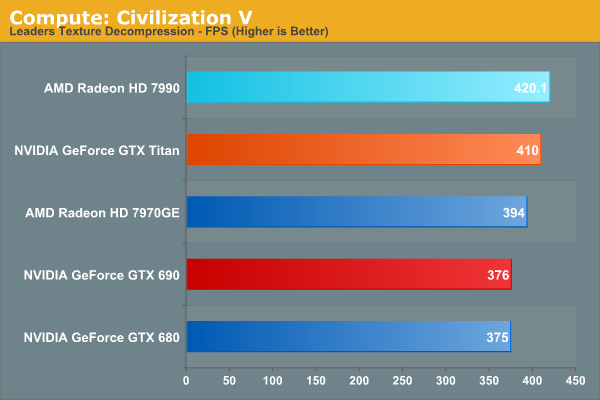
Civ V's texture compression routines are technically mutli-GPU capable, but multi-GPU scaling has never been particularly impressive here. So this test mostly reinforces what we already know about the Tahiti GPU being very capable in most DirectCompute workloads.
Our next benchmark is LuxMark2.0, the official benchmark of SmallLuxGPU 2.0. SmallLuxGPU is an OpenCL accelerated ray tracer that is part of the larger LuxRender suite. Ray tracing has become a stronghold for GPUs in recent years as ray tracing maps well to GPU pipelines, allowing artists to render scenes much more quickly than with CPUs alone.
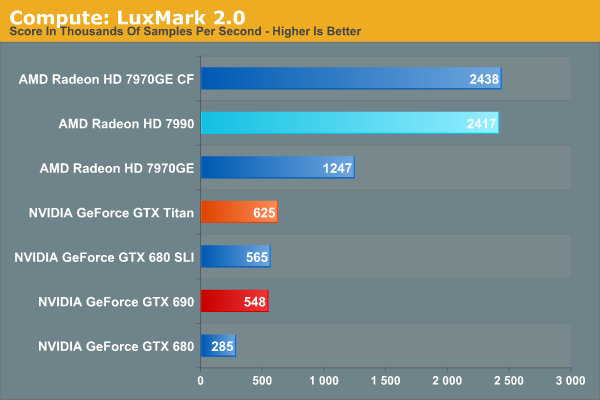
The 7990 isn’t billed as a compute product, but that doesn’t mean it’s at all weak at compute. On the contrary, as LuxMark doesn’t hit the ROPs hard the 7990 has no trouble staying under its 375W target, allowing it to sustain 1000MHz indefinitely. As a result the 7990 takes AMD’s compute advantage and runs with it. The 7990 is a bit more 2x the cost of a 680, but it’s 8.5x faster. Even against GTX Titan the difference is just short of 4x; NVIDIA simply doesn’t do well in our OpenCL tests.
Our 3rd benchmark set comes from CLBenchmark 1.1. CLBenchmark contains a number of subtests; we’re focusing on the most practical of them, the computer vision test and the fluid simulation test. The former being a useful proxy for computer imaging tasks where systems are required to parse images and identify features (e.g. humans), while fluid simulations are common in professional graphics work and games alike.
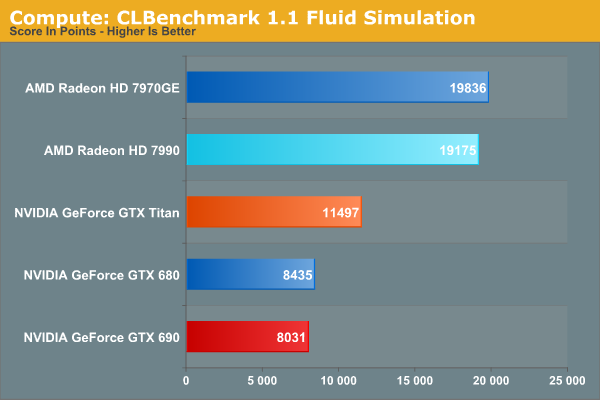
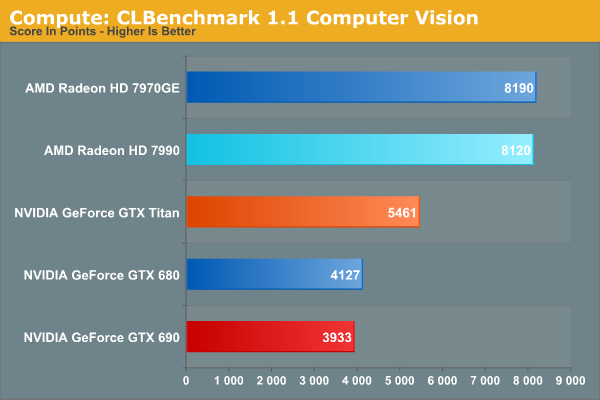
These two CLBenchmark sub-tests aren’t multi-GPU capable, so the performance of the 7990 is essentially dictated by its first GPU. All that means however is that the 7990 is once again at the top of the charts, well ahead of NVIIDA’s other cards and beating Titan by 50%-100%. At the same time this is a good reminder that not every compute task scales well across multiple GPUs, which is why single-GPU products still have a strong place in the GPU compute world.
Moving on, our 4th compute benchmark is FAHBench, the official Folding @ Home benchmark. Folding @ Home is the popular Stanford-backed research and distributed computing initiative that has work distributed to millions of volunteer computers over the internet, each of which is responsible for a tiny slice of a protein folding simulation. FAHBench can test both single precision and double precision floating point performance, with single precision being the most useful metric for most consumer cards due to their low double precision performance. Each precision has two modes, explicit and implicit, the difference being whether water atoms are included in the simulation, which adds quite a bit of work and overhead. This is another OpenCL test, as Folding @ Home is moving exclusively OpenCL this year with FAHCore 17.
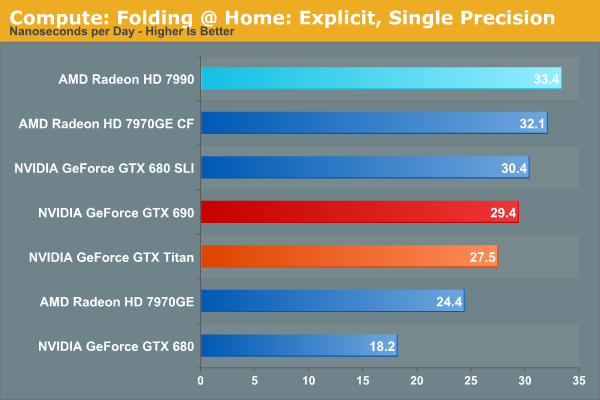
Only FAHBench’s explicit mode is multi-GPU capable, and even then the scaling to multiple GPUs isn’t great. Still, it’s enough to help the 7990 take the top spot on this benchmark, even with NVIDIA’s latest drivers slightly closing the gap. What’s particularly interesting here though is that the 7990 is faster than the 7970GE CF, and that’s not a fluke in our results. The 7990 should by all means be at least a bit slower, and more if throttling kicks in. It looks like we’re seeing one of those rare cases where the GPUs are benefitting from the presence of the PLX bridge, as going through the relatively close-by bridge is faster than in a two-card setup where the GPUs would have to communicate through the CPU/Northbridge. However this is the only time we see such an advantage; in most other compute scenarios – let alone gaming – the PLX bridge won’t have any kind of notable impact.
Wrapping things up, our final compute benchmark is an in-house project developed by our very own Dr. Ian Cutress. SystemCompute is our first C++ AMP benchmark, utilizing Microsoft’s simple C++ extensions to allow the easy use of GPU computing in C++ programs. SystemCompute in turn is a collection of benchmarks for several different fundamental compute algorithms, as described in this previous article, with the final score represented in points. DirectCompute is the compute backend for C++ AMP on Windows, so this forms our other DirectCompute test.
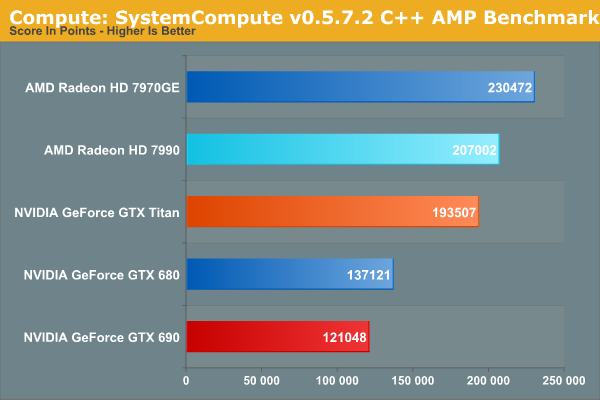
SystemCompute isn’t multi-GPU capable, so once again we’re leaning on the 7990’s first GPU. To that end we find the 7990 in second place, but we also see the 7790 clearly trailing the 7970GE by more than we’ve seen in our other compute benchmarks. SystemCompute does do a lot of I/O, so if FAHBench is the ideal case for showcasing the benefits of the PLX bridge in GPU to GPU I/O, then SystemCompute is good case for showcasing the drawbacks of the PLX bridge, mainly the higher I/O latency. It’s not enough to cripple the 7990 – it’s faster than the GTX Titan even here – but it does cost the 7990 some performance.










91 Comments
View All Comments
Nfarce - Wednesday, April 24, 2013 - link
Uhm, that Bundle is only "worth $350" to those who would USE it, as in those who haven't already purchased the games, let alone those who wouldn't play them (I never was a Tomb Raider or Bioshock fan, and I already have Crysis 3 and FC3). Think a little bigger next time.Nfarce - Wednesday, April 24, 2013 - link
Oh, and those are downloads only, which are NOT resalable...unless you like passing along your personal information to the buyer.R0H1T - Thursday, April 25, 2013 - link
The point still stands regardless of the game bundle, its like saying the free accessories you get with your phone/tablet are useless because you have a better pair of headphones at home ! The same goes for bitcoin mining, like discount coupons you don't necessarily have to use them but they certainly aren't worthless for people who actually do care about every penny they spend !nathanddrews - Wednesday, April 24, 2013 - link
GPU Bench 2013 - broken linksEvery selection I make under DX11 brings me to the following page:
http://www.anandtech.com/bench/CPU/2
Speaking as one of those wackos that still plays games on a CRT, I have to admit that the entire state of GPUs is pretty bad. You've got to spend a mortgage payment just to get over 120fps @ 1080p maxed out on recent titles. Software seems to have evolved tremendously, offering cinematic levels of detail, but GPUs have not kept pace. The move to 60Hz LCD has sadly let GPU manufacturers off the hook. If we're looking at mainstream 60-120fps 4K displays this year and 120fps 8K displays following close behind, then AMD and Nvidia have their work cut out for them. They need to push a LOT more pixels MUCH faster than they are now. I can tell you right now, I'm not going to be impressed by 4K @ 30Hz.
iMacmatician - Wednesday, April 24, 2013 - link
I noticed that too. Hopefully they fix it.Ryan Smith - Wednesday, April 24, 2013 - link
The web devs fixed it this morning.nathanddrews - Thursday, April 25, 2013 - link
Fantastic, thanks!Wreckage - Wednesday, April 24, 2013 - link
Late, not faster than the 690 and it uses a lot more power. Throw in the stuttering issues and this may be the biggest hardware disappointment of the year.eanazag - Wednesday, April 24, 2013 - link
NVidia needs to up the power and VRAM on the 690 part. I am sure that the additional VRAM accounts for some of the additional 75W AMD is working with. Maybe 10W; 20W at most. NVidia needs to flex that 690 since they have the TDP room and spank AMD. I saw a lot of game favoring in the review. Luckily for Nvidia that compute isn't a big deal for today. AMD smokes it in compute.iMacmatician - Friday, April 26, 2013 - link
In a few months (given the 770 and 760 Ti rumors), they might be able to do a refresh with revised GK104s and give 8 GB of RAM and clock bumps over the 690 in the same TDP.